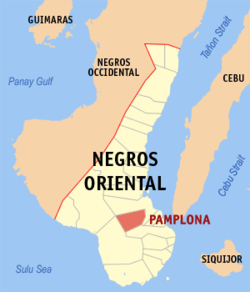Pamplona, Negros Oriental
| Pamplona | |
|---|---|
| Municipality | |
 Map of Negros Oriental with Pamplona highlighted |
|
| Location within the Philippines | |
| Coordinates: 09°28′N 123°07′E / 9.467°N 123.117°ECoordinates: 09°28′N 123°07′E / 9.467°N 123.117°E | |
| Country | Philippines |
| Region | Negros Island Region (NIR/Region XVIII) |
| Province | Negros Oriental |
| District | 2nd district of Negros Oriental |
| Established | 1950 |
| Barangays | 16 |
| Government | |
| • Mayor | Janice Degamo |
| • Vice Mayor | Edgardo Retes |
| Area | |
| • Total | 202.20 km2 (78.07 sq mi) |
| Population (2010) | |
| • Total | 34,906 |
| • Density | 170/km2 (450/sq mi) |
| Time zone | PST (UTC+8) |
| ZIP code | 6205 |
| IDD : area code | 35 |
Pamplona is a third class municipality in the province of Negros Oriental, Philippines. According to the 2015 census, it has a population of 37,596 people.
Originally the place was called “Tampa”, named after a big shady tree located at the heart of the town. The naming of the place into Pamplona has two versions:
The municipality of Pamplona is located 38 kilometres (24 mi) north-west of Dumaguete City, the capital City of Negros Oriental, and 7.5 kilometres (4.7 mi) west of the city of Tanjay.
Tanjay bounds it on the north, on the east by the municipality of Amlan and the city Tanjay, on the south by the municipality of Sibulan and on the west by Sta. Catalina.
Pamplona is politically subdivided into 16 barangays.
Pamplona, then a barrio of Tanjay, was created into a municipality by virtue of Republic Act No. 535 enacted on June 16, 1950. The law was authored by Pedro Bandoquillio, elected congressman in 1947. Since its creation, it has been administered by six municipal mayors. They were the late Juan Cañaveral, Sergio Aniñon, and late Apolinario P. Arnaiz, Sr., who managed to hold the reign for more than 22 years. After the EDSA Revolution in 1986, Douglas T. Diago was appointed as Officer In Charge, ran and won in the 1987 election and took the reign for twelve years, managing to complete his three term of mayorship from 1986-1998.
The late Wenceslao E. Duran, the undefeated politician, took hold of the administration for a brief period, after winning the 1998 election. He died of cardiac arrest while delivering his address during training in the municipality on December 18, 1999. Atty. Ricarte R. Valencia, who was then the vice mayor took office up to June 30, 2001. He ran for the post and lost in the election. Winning in the three elections in 2001. 2004 and 2007, the young, and energetic Apolinario P. Arnaiz, Jr. now reigns in his three terms of office.On May 2010 Election, the brother of Apolinario P. Arnais, Jr., Apollo P. Arnaiz who won the election and reigns in his two terms of office. On May 2016 election, Janice Vallega Degamo won as the first lady mayor of the municipality.
There are 243 food establishments operating in the municipality, 218 or 90% which have sanitary permits.
There are 10 sand and gravel companies operating in the municipality, 6 Copra Buyer and 5 Hog Buyer.
Agriculture continues to be the main economic activity in Pamplona as it played an important role in the development of the town. The main crops raised in the place are sugar, coconuts and bananas. Other crops such as corn, rice and other root crops grows in areas where accessibility to farm to market roads is rare. Coconut is the largest crops raised accumulating 3,676 hectares, followed by sugar 3,432 hectares and corn, 1,022 hectares. Only 107 hectares are irrigated rice land while 643 hectares are upland rice. Of the total agriculture areas of the municipality, 11,395 is strategic areas for development of Agro-industrial crops, 1,925 hectares for food crops while 925 for High Value Crops. Other agri-related economic activities which greatly helped in the increase of farmer’s income is livestock raising. Record shows that livestock raised includes large cattle, swine, chicken, goats and many others. Other information on agricultural support facilities are shown in the following presentation.
...
Wikipedia

